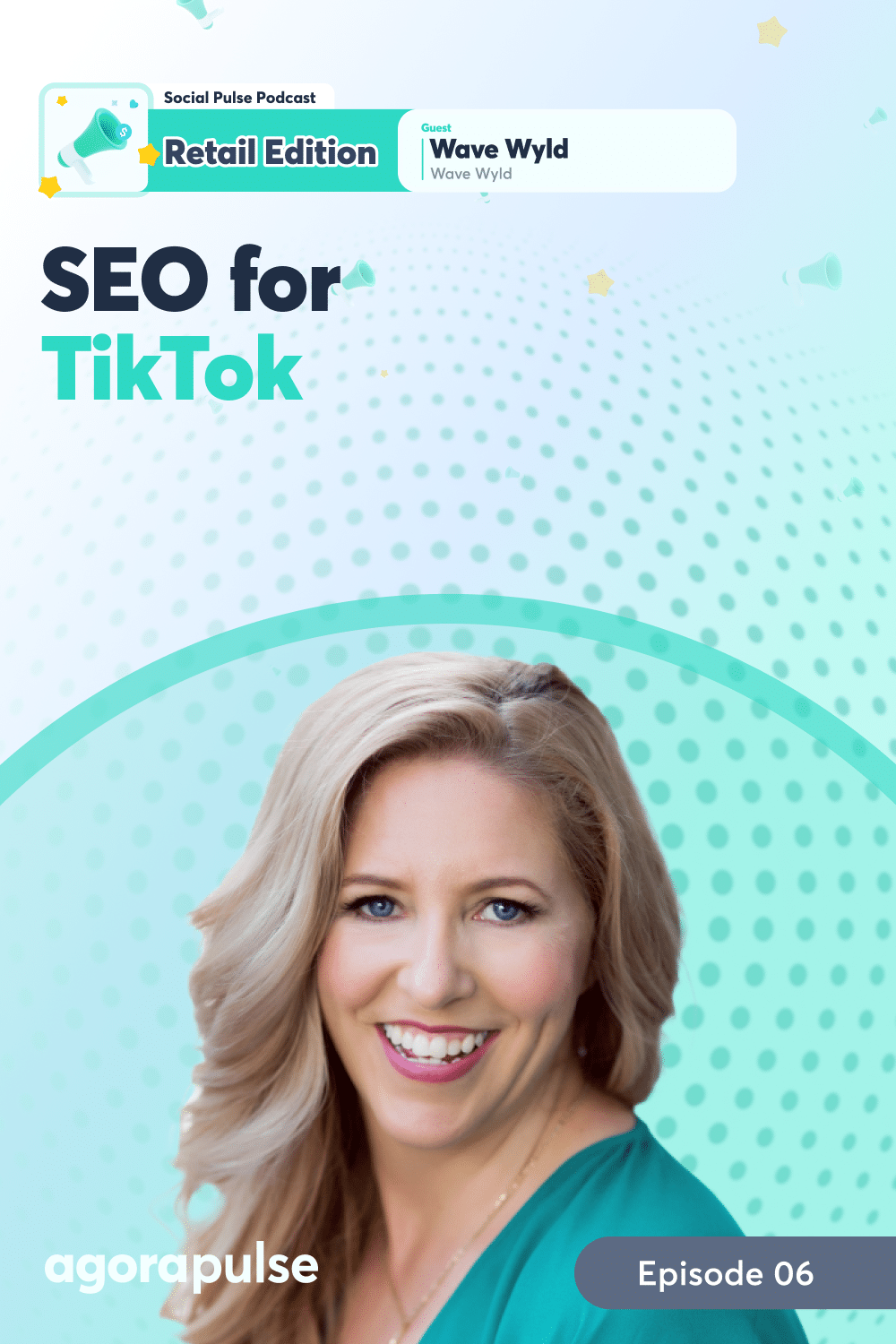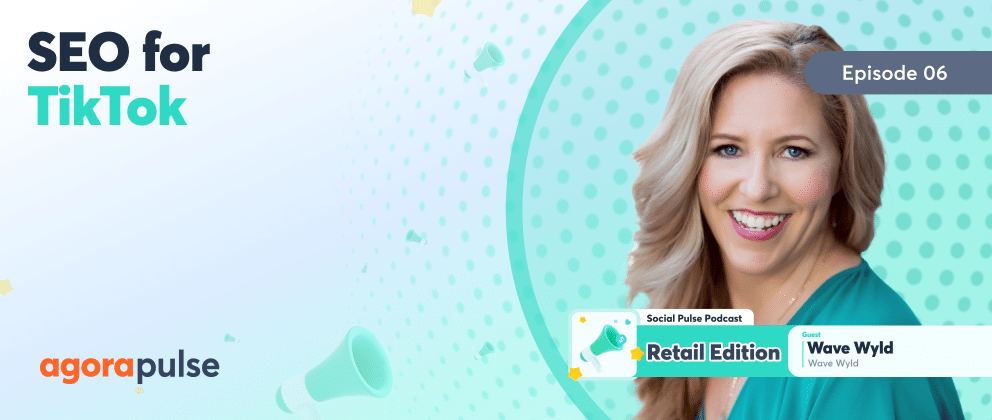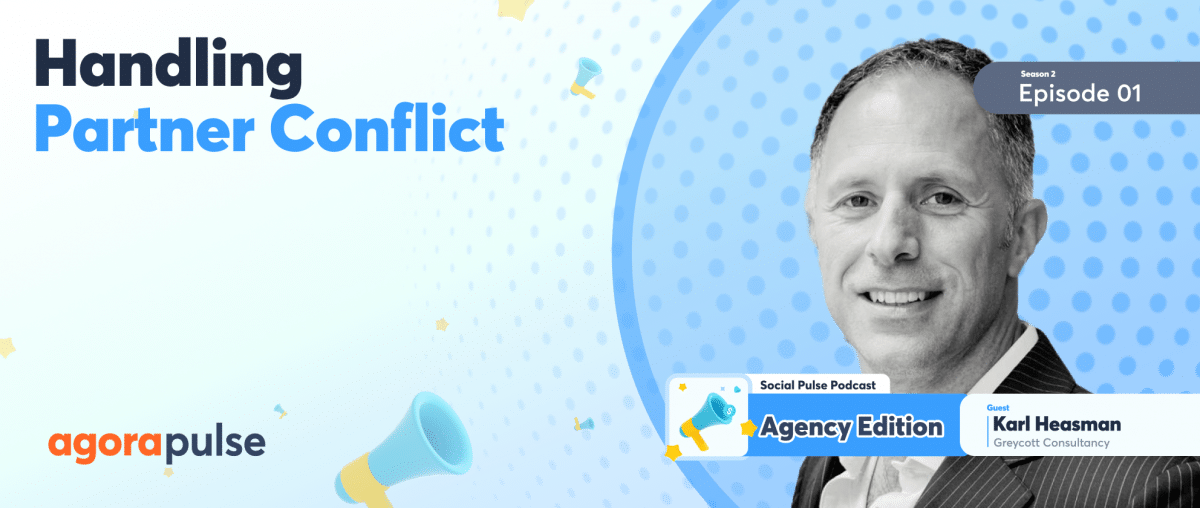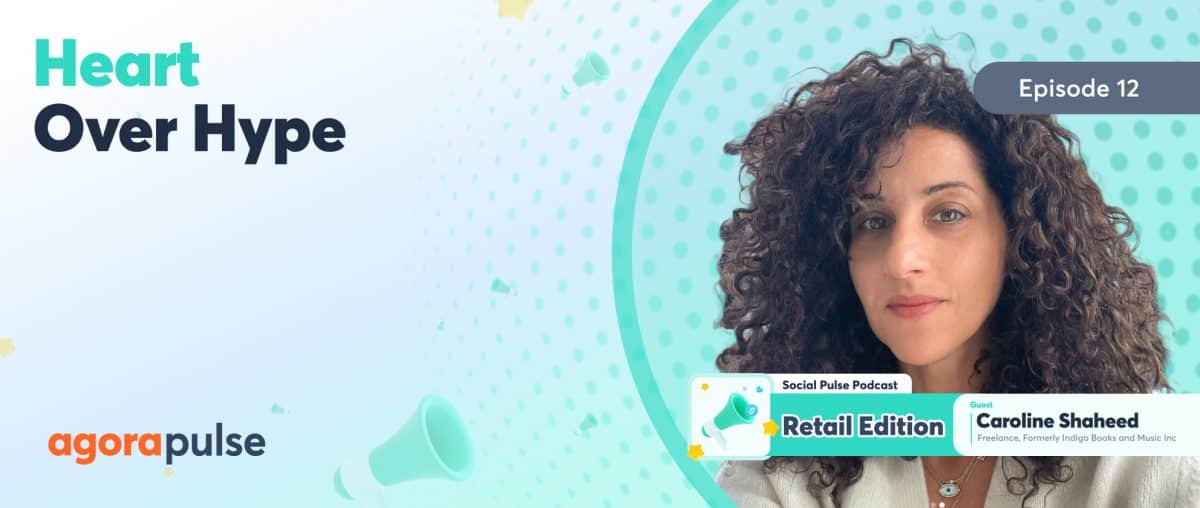TikTok is clearly a dominating platform for retail brands. But did you know that studies are showing that TikTok audiences—Gen Z in particular—are increasingly using that platform as a search engine rather than Google or alternatives?
Have you considered whether or not how your content and products might appear in a TikTok search? How do we make sure it’s our brand and products and solutions that show up when our target audience is searching on TikTok? How do we modify our TikTok strategy to accomplish multiple goals?
That’s exactly what Wave Wyld is going to talk to us about in this episode of Social Pulse Podcast: Retail, hosted by head of Strategic Partnerships at Agorapulse, Mike Allton. Listen to the entire podcast below or read on for the highlights.
Wave is a TikTok marketing and trends expert. She’s helped thousands of creators and business owners grow their TikTok accounts with a content first and a community approach so that they can make more impact and Profit. She launched her brand on TikTok as the Queen of Trend Alerts, which then started the movement of Trend Alert style videos that have become a mainstay within the social media industry. Wave participates in Creator community programs with TikTok and YouTube, and regularly appears in national media top-rated podcasts and social media summits.
TikTok Trend Alerts
Mike Allton: As I mentioned in the green room, you are our expert in TikTok, and you are going to help me and our audience, hopefully, understand a little bit more about this TikTok SEO thing.
But first, can you start by sharing just a little bit about how you got started on TikTok and the kind of consulting work that you do now?
Wave Wyld: I joined TikTok in early 2020. Previous to that, I had a photography business where I was creating content, essentially creating a video and photos for entrepreneurs doing personal brand photography. And when the pandemic hit, things got a little bit slow. I had an Instagram coach-friend say, “Hey, you should join TikTok. I just think you’d like it over there.”
I got on the app. I didn’t know what I was doing, and it was completely overwhelming. When I started making videos, I had one pop off and go semi-viral, and that’s what gets you hooked.
I got hooked on TikTok and just fell in love with the platform: the creativity, the fun, the vibe, the authenticity over there. And I was just really amazed at what content creators were doing. So I started sharing about my TikTok experience with the rest of my audience, and I was getting so many questions, and then it was just like a lightbulb moment.
I could help people, business owners specifically, use TikTok as another social media marketing tool. So I quickly did a pivot and started learning everything I could about TikTok. Obsessed with it. So I was obsessed with the platform, and I launched my coaching business. And now what I do is I have a membership that I run, absolutely love doing it. And I do one-on-one consulting.
SEO on TikTok
Mike Allton: Our topic of the day: search engine optimization for TikTok.
TikTok, really? Is that even a thing? I mean, how has that come about, and how is it different than other social networks?
How can you do SEO for TikTok?
Wave Wyld: It’s crazy. It is a thing, and it’s actually been on TikTok for the past few years, but I’ve noticed over time it is really been improving and it’s so powerful.
I’ll watch a video and then keep scrolling, and maybe I want to find that video again or find that sound, I can say something about the video or even maybe words in the sound in the search, and I’ll be able to find it again.
What I mean by that is that the results are so powerful and so specific. It’s so easy to find information. Whereas when I go on Instagram to use the search, I just can’t find anything I’m looking for.
So, [TikTok] is a really, really powerful search engine. I would say as powerful as Google. People are using it for anything.
I’ve had students and friends say they search local restaurant recommendations, trip planning. They’re searching for specific products or even just entering a problem they have just like you would on Google, you know, maybe something like “How to Treat Acne.” People are searching for that in TikTok and looking at the results.
I do this myself. Sometimes, I see ads. This is a new thing I’ve been doing: I see ads on Facebook for makeup products or clothing from a brand I’ve never heard before, and I immediately go to TikTok. I type the brand name and review, and I will watch review videos just to see if it’s something worth spending my money on and what people actually say about it.
I’ve also used [TikTok] search as research in my business over the years. A lot of people use it for research, as well, for content ideas—but the thing is, when I get a client who’s on a certain side of TikTok or in a certain niche or industry that I’m not familiar with, I will go to search and see what accounts in that niche or industry are already doing just to get a feel for that side of TikTok.
You can go and search keywords related to your own niche to get inspiration or ideas.
There’s just so much you can do with search and it’s become this big thing, a traffic source. You can find all of these links for a lot of accounts in the same way how everyone says YouTube is evergreen content. It’s tied in with Google Search, so you can get discovered from a video you posted three years ago.
On the daily, I get notifications on videos that I’ve posted from two to three years ago, and people are engaging with that comment, they’re commenting, they’re following, and that’s so similar to YouTube, right? Like, it’s obvious people are searching for TikTok tips, and some of my older videos come up, and that’s what really, really blows my mind, is that it is really powerful. Valuable for this evergreen content.
Mike Allton: And that’s a really particularly important point, I think, because the retailers, those of you listening right now, you should have TikTok shops set up. Hopefully, you’re using like a Shopify or maybe Feedonomics to help make sure that those shops are automatically synced so that all of your products are on there.
As you’re creating videos that reference these products, you can be tagging them and making sure that people who are finding these videos through search go on to make a purchase.
Instagram is really hard to find anything. It’s basically a single keyword search. You can search a hashtag, you can search somebody’s name, you try to go a long tail, it’s not going to work. Facebook’s terrible because it’s such a closed ecosystem.
How to Start Getting Your Content Out There on TikTok
Mike Allton: For social media managers for brands, particularly retail, that are listening—they want to get their content seen by more TikTok users who are using search.
What should their first steps be?
Wave Wyld:
Step 1. You need to understand and know where TikTok is pulling its data from your video content, so that you can rank in search results
TikTok is looking at five key things (and these are in no particular order):
- The text on screen. So, any text that you manually type and put on screen.
- Verbal language
- Subtitles or closed captions, which is a repeat of your verbal language
- Hashtags
- Keywords, any of the words that you put in that caption space
So those five places, it’s pulling that data. You want to be optimizing all of those five places.
Step 2. When you’re planning content, you really need to think about the purpose behind making that video.
If it’s educational or it’s showing something, you want to pick a few keywords that you would want to rank for.
For example, let’s say you sell a skin care product that helps with acne. (I’m just using the acne reference because it’s kind of easy to imagine.) And your video is showing how to use the product. You want to pick two to three keywords that you are going to say verbally in the video that will appear as text on screen, that will appear as hashtags. Maybe it’s like acne, acne treatment, skincare. Those are the three things you want to be repeating that in all five places so that you can optimize and improve your chances of being found.
UGC-Style Content
Mike Allton: I find this fascinating because I’ve had conversations with TikTok experts. A TikTok product manager at a retail summit a couple of weeks ago and I had a great conversation about creating TikTok videos and in that presentation. She was mostly advocating for UGC-style content, whether it’s literally a user creating the video or it’s the brand kind of making a video that looks like it’s UGC, but it’s not really.
The idea being that these are the ones that are going to resonate most with the audience and get the most engagement. It feels to me like what we’re talking about are really two different kinds of videos, and a brand might want to have a strategy where some of the video content is UGC, testimonial, social proof type content, right?
Where other content is literally, how do you use this product to solve this particular issue? I’m Jeff Sieh, and I’m here to talk to you about a new challenge that’s keyword-rich.
What do you think? Does that make sense to you? Does that resonate with you?
Wave Wyld: UGC content is super, super popular on TikTok. There’s UGC creators everywhere, and a lot of brands are using UGC content or making their own.
But, in that last example I gave, that could be made by a creator doing UGC content showing how to use the product or demoing the product. All that kind of stuff is UGC. So that’s definitely possible.
I think this is a little bit of the trick for brands on TikTok. If you don’t have maybe a marketing team or a dedicated social media manager, it’s going to be hard and difficult to figure out how are you going, you know, you need a TikTok strategy. So it’s best to have someone dedicated to TikTok who’s able to determine like, what types of content you’re going to make.
There should be a mix. So maybe you’re doing some UGC. Who’s going to make that content? Is it the social media manager? These are all a lot of questions that need to be answered when it comes to brands taking on TikTok and joining TikTok and figuring out what their strategy is.
Mike Allton: In our previous episode with the Five Below social media manager, Julia Wolf, that’s literally what she did. She works in an office that’s above a Five Below store. So she’ll decide in advance what her content is going to be. She’ll go downstairs, do some shopping, bring it upstairs in the studio, create some shots up there, then go back downstairs into the actual shop and create some content there with her phone. So it’s very UGC-style.
Creator Search Insights Tool
You’re talking about the need to have a TikTok strategy. Does TikTok help with this?
Wave Wyld: Yes, there’s actually a new one that was released in mid-March called the Creator Search Insights Tool. The way you find it in the app is you go to search, and you type in “Creator Search Insights” and a little button, a little icon and a button will show up and then you tap on that.
And this is an absolutely amazing tool.
It will show you:
- What people are searching for on the app related to your niche or industry
- Content gaps and those are highly searched topics that they don’t have enough videos for
- What your followers are searching
- Trending topics
- Trending topics for specific verticals such as fashion, sports, food, tourism, all those things
It’s a really mind-blowing tool. You can also just search any keywords that you would use related to your own niche and find what people are searching for related to those and then you know exactly what your keywords should be.
Is There a Recommended Length for TikTok Content?
Wave Wyld: TikTok provides a huge caption space. I think it’s close to 4,000 characters, but that doesn’t mean you should be using all 4,000 characters.
For one thing, reading the captions on TikTok is not typical of user behavior. It’s a video-first platform, so it’s not like Instagram where the captions are a part of the content or that caption space. You want to keep it fairly short.
I don’t believe or teach keyword stuffing, and I have not seen it make a difference. I do see people do that on TikTok, and I don’t think it helps at all. It actually will confuse the algorithm, I think, if you start putting in transcribed 20 to 50 to 100 different related words.
This is why I say pick two to three specific ones that you want to rank for. I’ve seen more success with that.
In your caption, you want to keep it fairly short. Try not to keyword stuff, just optimize it with a few of those keywords. Typically, you know, you see people say a little bit something about the video that maybe teases, what you’re teaching or what’s happening.
There’s some sort of call to action. Whether that’s to get into the comment section or to follow it or save some sort of engagement-based call to action, or maybe it’s some sort of promotional call to action. So that’s what you’re going to do in that caption space.
Of course, there’s all kinds of other strategies for that, but basically, when it comes to SEO optimization, that is what you want to do.
Mike Allton: I appreciate that because I need that simple, single strategy.
Speaking personally, I have my own social media brands, and I don’t have an assistant, so I’m managing all those profiles myself. I need a consistent approach.
Hashtag Strategy
What about hashtags? What should my hashtag strategy be?
Wave Wyld: Hashtag strategies have totally changed on TikTok.
I used to teach back in 2020-2021 to use smaller hashtags, use a variety. And now the algorithm is so much better. You don’t really need hashtags to help it, to tell it like who to show it to.
It knows just by analyzing your video content.
I only use hashtags for the purpose of ranking in SEO. So if I’m going to make a video specifically about your TikTok bio and how to optimize that. I am going to pick those two to three keywords, and I will definitely use them as a hashtag. So before I used to say, “Stay away from the hashtags that have billions of views and you want to use the smaller ones.” But now I use the big ones because they help with ranking. So hashtags completely changed. A lot different than other platforms.
Mike Allton: We’re posting videos that are keyword-rich in what we’re talking about and then text on top of them. We’ve done brief captions that use the keywords with those two or three key hashtags.
How do we know whether all this is working?
Measuring TikTok Success, SEO, and Impact
Does TikTok have any kind of metrics that we could rely on, which that are specific to search?
Wave Wyld: Guess what? They do! This is also just insane and gets me so excited because they actually do give us data.
There was an update a few months ago. I checked my analytics one day, and under traffic sources for your content in the TikTok analytics, it now gives you search traffic.
And if you get enough search traffic, that little link where it says search will be highlighted, and you can tap on it. And it will actually show you clicks and impressions and where you are ranking on average. This really blows my mind away because before that, a year ago or even six months ago, we were totally guessing when it came to SEO.
And now we actually get some data with it, which just blows my mind. So, a really, really cool feature. Definitely check out. If you don’t have it, try updating the app. This is one of the things with TikTok that’s a bit frustrating is that the features are always changing for everyone. Always update your app to see if you have these features.
Mike Allton: One of the questions I like to ask all of my guests is: How are you currently measuring the business impact of social media? You could be answering this from a variety of perspectives, Wave, since you are, like I said, one of our experts. You could be looking at it from your own perspective, from your client’s perspective, specific to retail or not. That’s up to you.
Wave Wyld: Yeah, I’m going to keep this TikTok-specific because that’s my expertise. That’s my jam now.
I was asked this question, a similar question recently about TikTok vs. Instagram. And the way that someone asked me, “How do you drive traffic on TikTok? Like, what tools do you have?” And I’m like, “Well, if it’s organic and you’re not using ads, all we have is your link in bio, your website field that appears on your profile page.” You also have that on other social media platforms.
That is the main source for driving traffic on TikTok.
It’s really important if you want to measure conversions that you are either using a link in bio tool that is giving you analytics that shows where people are clicking and how many clicks you’re getting on different links. Or that you’re using maybe some sort of pixel on your website.
A lot of business owners will also offer more of the small business owners will offer a little discount code, you know, a 10 percent discount when they’re shopping. That way, you can track traffic from TikTok and see more of that kind of conversion.
Otherwise, your TikTok analytics is really powerful. There is a ton of data in there. I would definitely check out.
Mike Allton: And I would add that as a retailer, you have a benefit over many other businesses because you can use that shop feature that we talked about before, where you can have your entire product catalog listed inside of TikTok. And then you’re going to get actual TikTok shop metrics on top of everything else.
Whereas like me working for Agorapulse as a SaaS company, we can’t leverage that, so we have to rely on, as you said, that link in bio.
What’s In Wave Wyld’s Tech Stack?
We’ve talked about a couple of tools, mostly some internal tools to TikTok. What other tools are in your tech stack? And they don’t have to be necessarily for TikTok, but I, again, this is another question I’d like to ask all my guests because as marketers, we want to geek out on tools.
We want to know what we’re missing. What are you using, Wave?
Wave Wyld: I love geeking out on tools, and I have geeked out on a lot of AI tools. I don’t talk about this so much on my TikTok, although lately I’m getting a ton of brand sponsorships for AI tools.
Love playing around with the AI tools, but I will say I don’t use them a lot in my content.
Of course, there’s ChatGPT, but I’m kind of liking Gemini a little bit more these days. I love Perplexity. Perplexity is awesome. I use that for research. It saves you so much time.
If you want me, I can talk about it a little bit. What Perplexity does is say you’re looking for information instead of using Google. It’s going to give you everything. It’s going to answer your question, and it’s going to give you the sources. So instead of going to Google and typing your question and then seeing all the links and visiting every page and kind of discerning what information is important and what’s not, it will just give you all the sources, and it’ll answer your question. Saves a lot of time, love Perplexity.
Other than that, I’ve played around with Midjourney. I have Canva, Adobe Creative Suite—I am a tool junkie, probably have too many tools. I don’t use a lot of the Reel repurposing tools because I don’t make a lot of long-form content. So I’m not really repurposing them so much. However, my husband has a podcast, and we’re helping them with that. And we’re using Riverside, and I will say I’m really impressed with their AI tools. They do AI show notes, which is really cool.
And they do the AI clips so I wouldn’t need to use the tools another tool to repurpose that. But you know, a lot of these platforms all have that built-in now. And that’s the thing with all of these platforms, they’re all building in their own AI features. So that’s just kind of the stuff that I’m playing around with lately.
Mike Allton: I love that you took this to AI because that’s obviously a frequent topic of conversation across podcasts from the MarTech Show to Agency Edition to Retail Edition.
Perplexity is awesome. I’ve been using Magai quite a bit, which allows me to bounce back and forth between ChatGPT and Midjourney or Anthropic. And it’s all one single interface in one subscription, which is super helpful. Now, earlier in the show you talked about learning TikTok, and I promise we’d get back to this because I did want to do this as my last question to you.
What are some of the resources that you turn to today that are current to to learn TikTok, to keep up with maybe social media trends in general, and these could be people. Podcasts, blog posts, TikTok channels, who are you following or where can we go for resources?
Wave Wyld: I sign up to a ton of marketing newsletters.
I would say the Social Media Examiner and Social Media Today is really good. You guys are good. Agorapulse, your Facebook community, is awesome. Shout out to Deb Mitchell. I’m on Neil Schaefer’s list. What else? I don’t listen to a lot of podcasts, but Google Alerts is my bestie, especially for TikTok.
I have several alerts set up. And then in the morning, that’s typically what I do. The first thing is I drink my morning cup of tea, and I go through all my Google Alerts and look at kind of news articles of what’s kind of coming up on the radar related to TikTok. but that’s, yeah, that’s pretty much it.
Mike Allton: We’re very much alike in that regard. I have my tea in the morning, so some Earl Gray and I’m scrolling through the five to 10 newsletters that I get. Most of them are daily newsletters. Some of them are just general news: the Times, Business Insider, Morning Brew, right?
But then those marketing newsletters—they’re just invaluable today just to keep up with everything that’s happening.
I appreciate you sharing those great ideas and suggestions and counts. Wave, you’ve been amazing.
This has been such an incredible and insightful interview. I know everyone’s heads are probably exploding right now with ideas and information overload. If they want to follow you, find out more, where should they go?
Wave Wyld: Of course, you can follow me on TikTok, Instagram, LinkedIn. It’s just my name: @wavewyld. You can check out my website to learn more about how to work with me and what I do.
Mike Allton: Fabulous. And we’ll have all the links in the show notes. That’s all we’ve got for today, friends.
But please do us a favor and find the Social Pulse Podcast Retail Edition on Apple. Leave us a review. We’d love to know what you think. Until next time.






